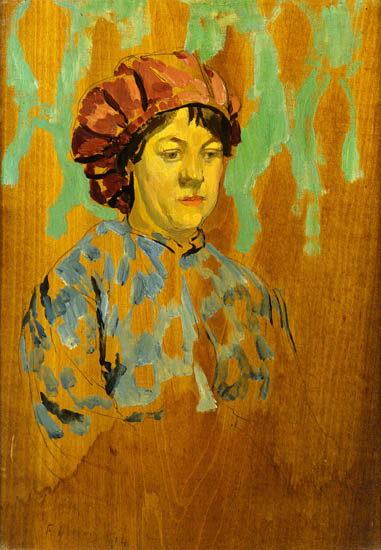
Catherine - A Newlyn Girl, 1914
Framed (ref: 5239)
Signed and dated 1914
Oil over pencil on board , 13 1/2 x 9 1/2 in. (34.5 x 24 cm.)
Tags: Frank Dobson oil panel pencil portraits

Signed and dated 1914
Oil over pencil on board , 13 1/2 x 9 1/2 in. (34.5 x 24 cm.)
Tags: Frank Dobson oil panel pencil portraits
In a plain oak Italian cassetta moulding.
Provenance: Mrs Joyce Conway; The Fine Art Society 1981 (4948)
Exhibited:
Arts Council of Great Britain, 1981 Kettle’s Yard University of
Cambridge, no. 21, lent by Mrs Joyce Conway; The Fine Art Society,
January 1981
Between 1913 and 1914 Dobson lived and worked in Newlyn. During this time he produced a a series of panels painted en plein air, many of which are portraits of locals, using primarily bright reds and greens and allowing the grain of the wood to play a part in giving form to the composition. In 1914 Dobson held his first one-man Exhibition of drawings and paintings at the Chenil Gallery.
After
World War I, however, he turned increasingly toward sculpture in a more
or less realist style. From 1946 to 1953 Dobson was Professor of
Sculpture at the Royal College of Art. He was elected to the Royal
Academy in 1953.
While Dobson was one of the most esteemed
artists of his time, after his death his reputation declined with the
move towards postmodernism and conceptual art. However, in recent years a
revival has begun. Dobson is now seen as one of the most important
British sculptors of the 20th century.
The art critic Brian
Sewell has recalled the great loss of much of Dobson's work after his
death in his column in The Evening Standard 16 March 1995: After his
death, his widow asked me to help her clear the studio at Stamford
Bridge, and I was appalled at the destruction that she wrought, smashing
to smithereens small clay and terracotta models, tearing fine drawings
in red and black chalk, hundreds of them, buring the fragments in a
dustbin, all because the subjects were erotic. I was allowed to save
pastel drawings of exotic and rare birds, and watercolours of farmyards
and a pastoral life long gone, but for the figures engaged in sexual
congress, face to face, head to toe and doggy style as explicit as any
by his old friend Eric Gill, Mrs Dobson would accept no plea that they
were beautiful, no argument that they were fired by a quality not to be
found in the “pure essence” of the torsos that survive, and like a
ferociously implacable angel at the Last Judgment, she bent to the
business of destruction.